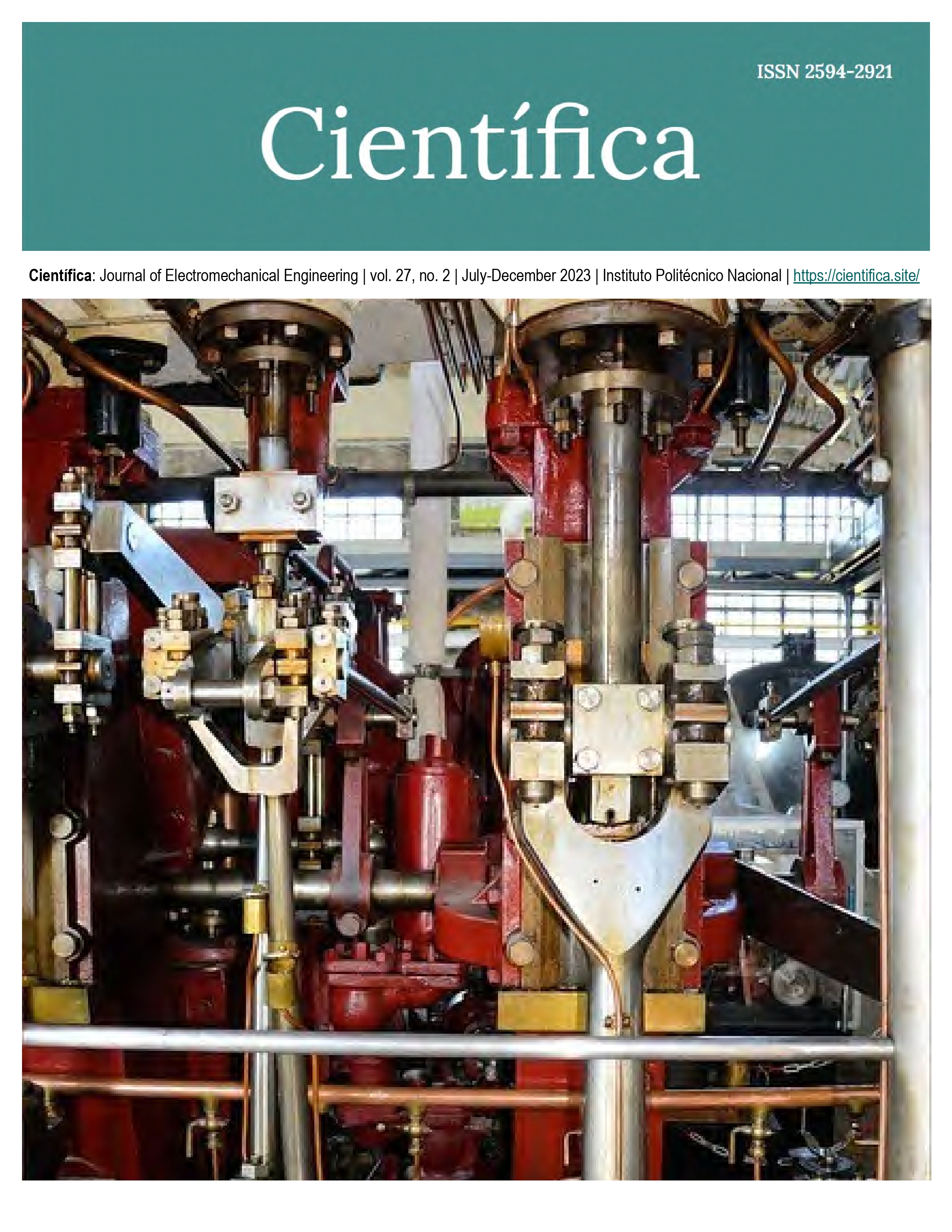Implementación de una interfaz háptica en Unreal Engine y la estimación de velocidades para reducir vibraciones
DOI:
https://doi.org/10.46842/10.46842/ipn.cien.v27n2a08Palabras clave:
interfaz háptica, derivadores, tiempos de muestreo, Unreal Engine, plataforma experimentalResumen
Este trabajo aborda la implementación de una interfaz háptica en Unreal Engine en conjunto con un robot de un grado de libertad. Unreal Engine es un potente motor gratuito de renderizado y simulación en el que se desarrolló un gemelo digital capaz de interactuar con una plataforma física mediante una comunicación bidireccional de posición y torque para seguimiento de trayectoria y reflejo de fuerzas. Se condujeron diferentes experimentos para validar la integración tecnológica ante distintas condiciones de operación. El resultado fue una plataforma de bajo costo, con una sensación háptica aceptable, y un entorno digital para visualizar, analizar y comprender la tecnología de gemelos digitales y los desafíos que se enfrentan. Se validaron además distintas estrategias para estimar la velocidad y reducir significativamente las vibraciones en el sistema producto de retardos en la comunicación, pues estas afectan negativamente la precisión y la calidad de la interacción robótica.
Referencias
C. Semararo, M. Lezoche, P. Hervé, M. Dassisti, “Digital twin paradigm: A systematic literature review”, Computers in Industry, vol. 130, p. 103-469, 2021.
Z. Wang, X. Liao, X. Zhao, K. Han, P. Tiwari, M. J. Barth, G. Wu, “A digital twin paradigm: Vehicle-to'cloud based advanced driver assistance systems”, en 2020 IEEE 91st Vehicular Technology Conference (VTC2020-Spring), 2020.
E. Glaessgen, D. Stargel, “The digital twin paradigm for future NASA and US Air Force vehicles”, en 53rd AIAA/ASME/ASCE/AHS/ASC Structures, Structural Dynamics and Materials Conference 20th AIAA/ASME/AHS adaptive structures conference 14th AIAA, 2012.
W. Yu, P. Panos, B. Young, E. Klinac, T. G. Walmsley, “Energy digital twin technology for industrial energy management: Classification, challenges and future”, Renewable and Sustainable Energy Reviews, vol. 161, pp. 112-407, 2022.
W. Kritzinger, M. Karner, G. Traar, J. Henjes, W. Sihn, “Digital Twin in manufacturing: A categorical literature review and classification”, Ifac-PapersOnline, vol. 51, pp. 1016-1022, 2018.
M. Faisal, F. Laamarti, A. El Saddik, “Digital Twin Haptic Robotic Arms: Towards Handshakes in the Metaverse”, Electronics, vol. 12, 2023.
A. Fuller, Z. Fan, C. Day, C. Barlow, “Digital twin: Enabling technologies, challenges and open research”, IEEE access, vol. 8, pp. 108952-108971, 2020.
C. K. Liu, D. Negrut, “The role of physics-based simulators in robotics”, Annual Review of Control, Robotics, and Autonomous Systems, vol. 4, pp. 35-58, 2021.
J. Resch, J. Ehrentraut, M. Barnett-Cowan, et al., “Gamified automation in immersive media for education and research”,» arXiv preprint:1901.00729, 2018.
F. Jiang, Q. Hao, “Pavilion: Bridging Photo-Realism and Robotics”, en 2019 International Conference on Robotics and Automation (ICRA), 2019.
Y. Zheng, S. Yang, H. Cheng, “An application framework of digital twin and its case study”, Journal of Ambient Intelligence and Humanized Computing, vol. 10, pp. 1141-1153, 2019.
G. Steindl, M. Stagl, L. Kasper, W. Kastner, R. Hofmann, “Generic digital twin architecture for industrial energy systems”, Applied Sciences, vol. 24, p. 8903, 2020.
Y. Lu, C. Liu, I. Kevin, K. Wang, H. Huang, X. Xu, “Digital Twin-driven smart manufacturing: Connotation, reference model, applications and research issues”, Robotics and computer-integrated manufacturing, vol. 61, p. 101837, 2020.
C. Boje, A. Guerriero, S. Kubicki, Y. Rezgui, “Towards a semantic Construction Digital Twin: Directions for future research”, Automation in construction, vol. 114, p. 103179, 2020.
J. Leudet, F. Christophe, T. Mikkonen, T. Mannisto, “Ailivesim: An extensible virtual environment for training autonomous vehicles”, en 2019 IEEE 43rd annual computer software and applications conference (COMPSAC), 2019.
S. Jeršov, “Development of Digital Twin in extended Reality with Unreal Engine”, Tesis, Tal Tech- School of Information Technologies, Estonia, 2020.
Y. A. El-Wajeh, P. V. Hatton, N. J. Lee, “Unreal Engine 5 and immersive surgical training: translating advances in gaming technology into extended-reality surgical simulation training programmes”, British Journal of Surgery, vol. 109, pp. 470-471, 2022.
Y. Wang, G. Zheng, D. Efimovk, W. Perruquetti, “Differentiator application in altitude control for an indoor blimp robot”, International Journal of Control, vol. 91, pp. 2121-2130, 2018.
Y. Matsumoto, S. Katsura, K. Ohnishi, “An analysis and design of bilateral control based on disturbance observer”, en IEEE International Conference on Industrial Technology 2003, vol. 2, pp. 802-807, 2003.
D. Yashiro, K. Ohnishi, “Performance Analysis of Bilateral Control System With Communication Bandwidth Constraint”, IEEE Transactions on Industrial Electronics, vol. 58, pp. 436-443, 2011.
H. Z. Tan, M. A. Srinivasan, B. Eberman, B. Cheng, “Human factors for the design of force-reflecting haptic interfaces”, Dynamic Systems and Control, vol. 55, pp. 353-359, 1994.
H. Li, L. Zhang, K. Kawashima, “Operator dynamics for stability condition in haptic and teleoperation system: A survey”, The International Journal of Medical Robotics and Computer Assisted Surgery, vol. 14, p. e1881, 2018.
A. Colomé, D. Pardo, G. Alenya, C. Torras, “External force estimation during compliant robot manipulation”, en 2013 IEEE International Conference on Robotics and Automation, 2013.
Repositorio de GITHUB: https://github.com/erick-man11/InterfazHaptica_UE5, 2019.
Descargas
Publicado
Número
Sección
Licencia
Derechos de autor 2023 Instituto Politécnico Nacional

Esta obra está bajo una licencia internacional Creative Commons Atribución-NoComercial-CompartirIgual 4.0.

